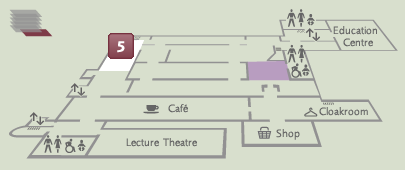Embroideries and Samplers from Islamic Egypt
A selection of 10th to 16th century embroideries from the Newberry collection at the Ashmolean by Marianne Ellis (published Oxford, 2001).

Publications online: 66 objects
- Reference URL
Actions
Textile fragment with interlocking hexagons and diamond-shapes
-
Literature notes
Because they are worked in different stitches and colours, the two embroideries illustrated (Nos. 33 [EA1984.463], 34 [EA1984.272]) look very different. However, they share the same geometric pattern, and only differ in the details within the diamond shapes. The basic unit is a Y-shape arranged in offset rows like the Y-fret patterns that decorate 14th century Mamluk Egyptian and Syrian metal basins and trays. The design appears on a tunic worn by a Mamluk courtier on the basin known as the Baptistère of St. Louis, now in the Louvre, Paris. To create the pattern on these embroidered fragments, every alternate row of the Y shapes has been omitted, resulting in the formation of diamond shapes within elongated hexagons. The pieces provide an interesting comparison between the effects produced by using different embroidery stitches. This one is worked in pattern darning in running stitch that is so similar in appearance to weaving with a supplementary weft. The result is pleasing but does not exploit fully the freedom offered by needle and thread. The stitch was much used on Islamic medieval textiles judging from the large proportion of the Newberry embroideries worked in it. -
Details
- Associated place
-
Near East (place of creation)
- Date
-
13th - 14th century (1201 - 1400)
Mamluk Period (1250 - 1517)
- Material and technique
- linen, embroidered with blue silk
- Dimensions
-
14.5 x 8.3 cm (length x width)
along length/width 22 / 22 threads/cm (thread count)
ground fabric 0.05 cm (thread diameter)
additional fibre, embroidery 0.06 cm (thread diameter)
- Material index
-
organic › animal › animal product › silk
- Technique index
-
assembled › woven › plain woven,woven › plain woven,
- Object type index
- No. of items
- 1
- Credit line
- Presented by Professor Percy Newberry, 1941.
- Accession no.
- EA1984.463
-
Further reading
Ellis, Marianne, Embroideries and Samplers from Islamic Egypt (Oxford: Ashmolean Museum, in association with Greenville: Curious Works Press, 2001), no. 33 on p. 51, p. 52, illus. p. 51
Barnes, Ruth and Marianne Ellis, ‘The Newberry Collection of Islamic Embroideries’, 4 vols, 2001, Oxford, Ashmolean Museum, cat. vol. iii, illus. vol. i
Location
Objects are sometimes moved to a different location. Our object location data is usually updated on a monthly basis. Contact the Jameel Study Centre if you are planning to visit the museum to see a particular object on display, or would like to arrange an appointment to see an object in our reserve collections.
Galleries
Publications online
-

Embroideries and Samplers from Islamic Egypt
Because they are worked in different stitches and colours, the two embroideries illustrated (Nos. 33 [EA1984.463], 34 [EA1984.272]) look very different. However, they share the same geometric pattern, and only differ in the details within the diamond shapes. The basic unit is a Y-shape arranged in offset rows like the Y-fret patterns that decorate 14th century Mamluk Egyptian and Syrian metal basins and trays. The design appears on a tunic worn by a Mamluk courtier on the basin known as the Baptistère of St. Louis, now in the Louvre, Paris. To create the pattern on these embroidered fragments, every alternate row of the Y shapes has been omitted, resulting in the formation of diamond shapes within elongated hexagons. The pieces provide an interesting comparison between the effects produced by using different embroidery stitches. This one is worked in pattern darning in running stitch that is so similar in appearance to weaving with a supplementary weft. The result is pleasing but does not exploit fully the freedom offered by needle and thread. The stitch was much used on Islamic medieval textiles judging from the large proportion of the Newberry embroideries worked in it. -

The Newberry Collection of Islamic Embroideries
A band of linked and interlocking hexagons, each containing a diamond. The band also has a border with hook motifs.
Notice
Object information may not accurately reflect the actual contents of the original publication, since our online objects contain current information held in our collections database. Click on 'buy this publication' to purchase printed versions of our online publications, where available, or contact the Jameel Study Centre to arrange access to books on our collections that are now out of print.
© 2013 University of Oxford - Ashmolean Museum



